
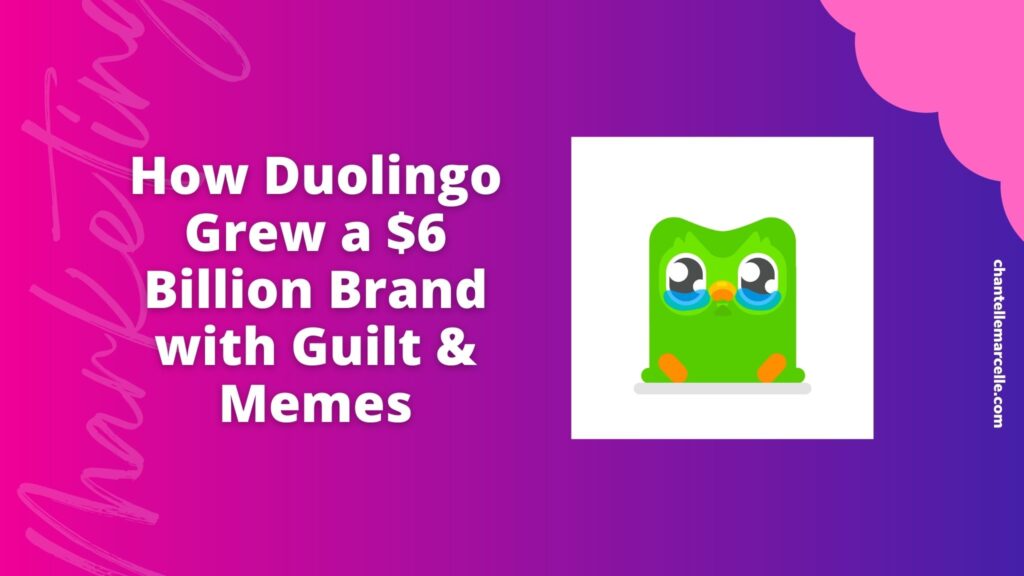
Duolingo’s $6-Billion Growth Marketing Case Study: Guilt, Memes & Farts (updated in 2025)
In This Article:
- Acquisition vs Retention: The Growth Equation
- Duolingo Background and Facts
- Duolingo at the Super Bowl
- So What’s the Story with Duolingo Guilt Marketing?
- User Response to Duolingo Guilt Marketing
- The Science Behind This Growth Marketing and Engagement Strategy
- Final Thoughts and Key Takeaways
Duolingo became a growth marketing case study for the modern age when they grew their TikTok account 40X over in under 5 months. They also took off as a standout brand among Gen-Z and a model for capturing the power of social media culture. In a way that felt authentic, not horribly forced.
A former user, I recently downloaded the app again because of all the buzz. I love the easy access to free, valuable educational content.
What I don’t love are the guilt trips baked into the customer marketing and product experience. Duolingo sends an abundance of communications to remind you to take lessons.
These aren’t simple touch points, though.
Read another post: What to Do When Your Organic Social Media Reach Is Tanking
They are pushy at best. Passive aggressive and naggy at worst. My mom’s texts asking when I’m coming to visit again (along with a story about 3 days of labor and a lifetime of motherly love and sacrifice) are more subtle.
But these touchpoints are not just haphazardly thrown together.
They’re based on an impressive, comprehensive growth strategy and millions of user data points.
Let’s look at the quirky growth marketing case study provided by Duolingo’s marketing, engagement and retention strategy.
Acquisition vs Retention: The Growth Equation
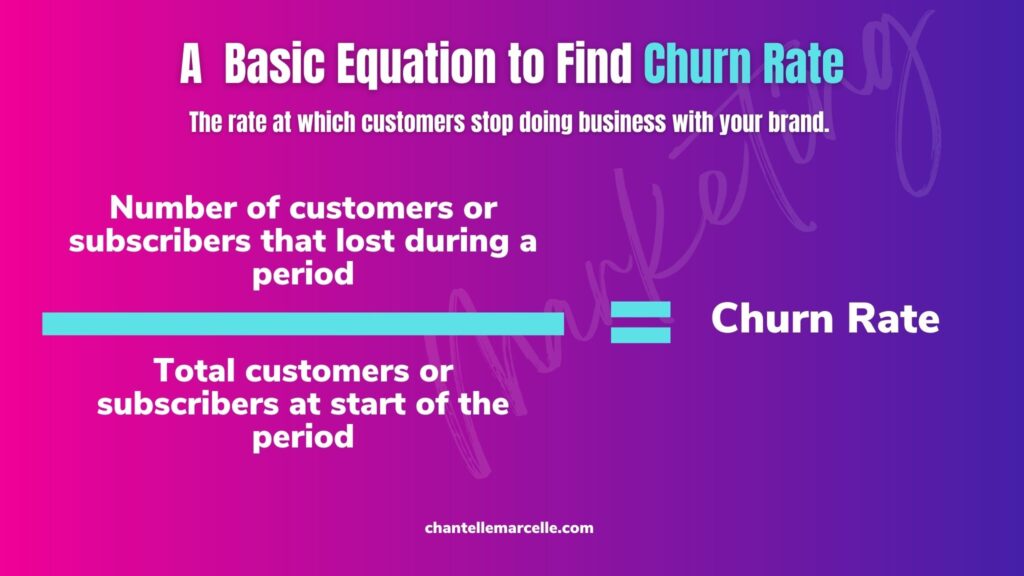
But first let’s talk about what’s at the heart of this matter: growth.
Scalable growth requires a cost-effective balance between acquisition and retention.
High customer churn is one of the primary drivers of inefficiency and high spend in marketing.
Churn means “the rate at which customers stop doing business with a company over a given period of time,” cancel their subscriptions/memberships, or fail to renew. The way companies measure it varies based on average time between customer purchases or length of subscriptions/memberships. Some look at churn over 3 months, others 6 months, etcetera.
Ultimately businesses want to avoid becoming a revolving door.
Figuring out ways to keep customers engaged matters even more depending on the industry.
And many mobile apps, like Duolingo, face significant difficulties with retention.
One out of four of us abandon an app after only one use. However, that app abandonment rate improves with savvy growth marketing tactics like:
- Dynamic messaging
- Profile-based targeting
- Location-based messaging
Which brings us to the Duolingo case study.
Before the Duolingo Growth Marketing Case Study: Background and Facts
Duolingo began developing in about 2009 and became available for all in 2012.
They secured millions in investments over the years from big names, including Google Capital and Ashton Kutcher’s firm.
Fun fact: The inventor of reCAPTCHA, Luis von Ahn, is a co-founder of this language learning app, along with his former student, Severin Hacker. (Hacker’s parents deserve a thank you for that all-too-perfect name.)
They shared a belief that education was too expensive.
Hence why Duolingo remains, even to this day, free to use. Unless you want an ad-free experience, in which case you can pay for a subscription.
From April 2020 to March 2022, their paid user subscriber base rose from 1 million to 2.9 million. By early 2023, most (80%) of their growth was attributed to organic channels, like their phenomenal social media presence. Word-of-mouth user referrals also played a big role.
Most importantly, it’s a fun and useful tool.
Features like hearts and score leaderboards make it feel like a game rather than a boring, required educational course.
Duolingo at the Super Bowl
One of the perfect Duolingo growth marketing case studies came in 2024.
When they ran a 5-second Super Bowl commercial that year, they knew the stakes were high. They needed high impact in only seconds.
And they achieved that, no buts about it.
Some incredible lessons from the campaign:
- Cross-functional partnerships between marketing and tech teams (engineering, product, etc) can deliver exponentially better results.
- When leaders take a chance on “weird” ideas, it sometimes pays off in a big way. This will be especially true as we see homogeneous AI-generated content creation increase.
- Developing creative in-house gives you a chance to stay closer to the overall process and ensure the results are absolutely aligned with your brand.
- Customer insights are valuable. Sometimes to the tune of millions. By knowing what their audience would respond to (based on community feedback and social listening), they nailed a major opportunity to stand out and connect with their base.
Plus, how many marketers can say they conducted hours of research into…fart noises?
So What’s the Story with Duolingo Guilt Marketing?
If you do a search on Twitter, numerous users have shared their reactions to the guilt-trip marketing strategy. Sometimes appreciative, but more often annoyed.
Duolingo stands by the method regardless of these tweets. Maybe even more because of the massive user response.
The brand’s machine learning team shared some of the secret sauce behind their strategy.
An advanced AI system determines which messages to send based on different factors.
The basics sound a lot like the way social media algorithms work. Serving up content, seeing how users respond, tailoring future content based on these behavioral patterns.
The Duolingo system developed based on over 200 million user interactions.
And it continues to provide interesting insights as it learns. Such as the fact that users learning different languages (such as learners of Chinese versus English) respond best to different engagement nudges.
According to Duolingo, the guilt trips were actually found to be 5 to 8% more effective at getting users re-engaged than other methods.
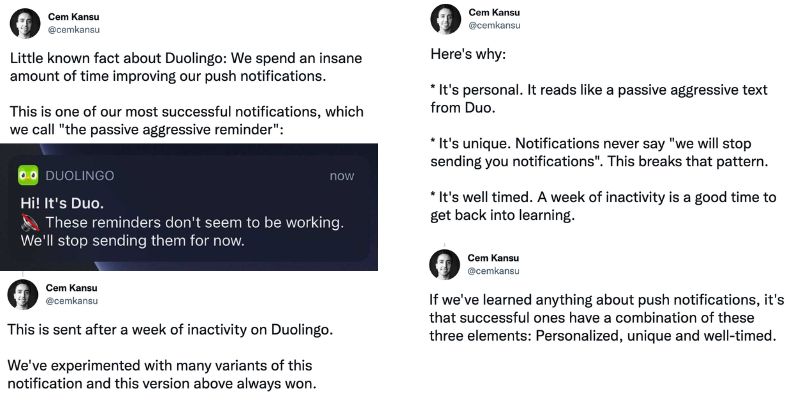
Duolingo VP of Product Cem Kansu posted a Twitter/X thread sharing that one of their most controversial notifications performs very well.
He said the notification shows the benefits of product and marketing communications that are:
- Personal
- Unique
- Well-timed
User Responses to Duolingo Guilt Marketing
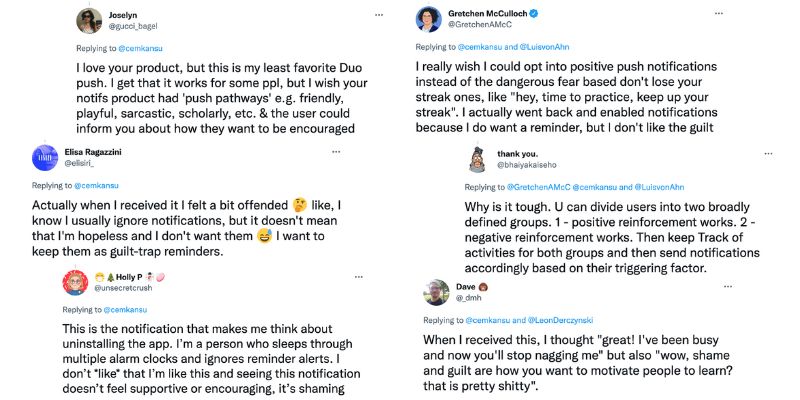
Responses to his thread pointed out potential issues, though.
Why not personalize the notification experience to the individual user’s preference? Shouldn’t users get to decide if they want more positive or motivating language? Or just opt out?
Some even said passive aggressiveness and guilt marketing turns them off from using the product at all rather than the intended effect.
The whole thing spawned the creation of the Evil Duolingo Owl meme.
It features the brand mascot, Duo the Owl (full name: Duo Keyshauna Renee Lingo), threatening users who don’t continue using the app for language lessons.
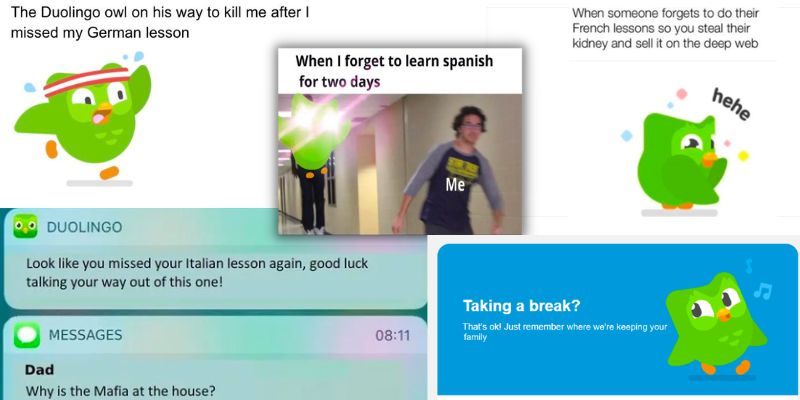
On their part, the team at Duolingo took advantage of the attention pretty brilliantly.
They regularly joke about it all with snarky marketing campaigns acknowledging their pushy practices.
It’s the kind of self-aware, tongue-in-cheek tone that fuels the brand’s social media and TikTok marketing success.
They embrace the mockery…and then incorporate it into their marketing.
As a result, Gen-Z + Millennials embrace the perceived brand authenticity.
That may be why their user base trends younger, with 60% of global users under age 30.
Some Duolingo marketing examples of this:
- Lawyer vs Duo fake-advertises legal services to anyone who’s been bothered
- Duolingo Push shows beloved mascot Duo stalking people to get them to use the app (check out this clever landing page)
- Responding to social media users in character like in this clever tweet
The Science Behind This Growth Marketing and Engagement Strategy
But trying to guilt your way to increased repeat customers still feels a little icky.
“Guilt can encourage negative attitudes and even anger.”
“For example, guilt appeals by commercial marketers can backfire because consumers may be turned off by feeling guilty. I would venture that because Duolingo is a commercial marketer, the use of guilt appeals may backfire.”
That’s a quote by Raji Srinivasan, a professor of marketing at the University of Texas at Austin’s McCombs School of Business.
“Shaming people is often associated with undesired behavioral outcomes, such as reacting defensively [or] withdrawing,” says Linda Hagen, an assistant professor of marketing at the University of Southern California Marshall School of Business.
According to one study on the effects of guilt appeal marketing:
- Repeatedly using guilt in marketing or ads can make customers start to permanently associate that product or brand with those negative feelings
- Customers could start trying to counter or argue against the message you’re presenting as a way of coping with the guilt and negativity they feel
- The effects of marketing based on negative emotions like guilt can vary a lot based on the personality or circumstances of the person watching
- Marketers should be careful to recognize the differences between causing guilt versus shame. One says “I have done something bad,” while the latter says “I am bad as a person”
Final Thoughts on this Duolingo Growth Marketing Case Study: “The Goose that Lays the Golden Eggs”
Ultimately Duolingo provides an incredible growth marketing case study for brands looking to add more authenticity and freshness to their strategies.
They lead the pack when it comes to TikTok and fresh organic social engagement, and they’ve connected with Gen-Z like few other companies.
They create viral moments with ease thanks to their consistency and research-backed tactics.
It made headlines when they announced the death of their owl mascot, Duo, in early 2025. Hit by a Cybertruck, allegedly. Celebrities like singer Dua Lipa, other brands, and thousands of social users all weighed in. And it made headlines again when they revealed the death was “staged” and brought dear Duo back. A company spokesperson said the campaign was all about community engagement (and of course, driving product usage).
Brilliant.
We’ve come to expect nothing less.
But the jury is still out on their use of pushiness, passive aggressiveness, guilt, and other negative emotions in their product engagement and retention strategy.
Personally, Duolingo is the first place I go when I’m looking to learn a language.
Read another post: Organic Growth Marketing Strategy Tips With Morning Brew
But the guilt trips are a big turn off for me personally.
I don’t need the push to feel disappointed with myself. I would rather Duo says, “Hey, great work at being so consistent for so long. Take some time if you need it. I’ll be here when you get back.” Or maybe even, “your next lesson will only take 3 minutes, get your lazy $*# in here!”
But you can’t deny the data. Many other users disagree with me.
And Duolingo calls notifications “the goose that lays the golden eggs.” They just work. Beautifully.
The team has doubled down on their notifications and put in place several processes to continue to optimize, while still protecting the success of that channel.
Three wins they identified include: introducing “a bandit algorithm, making UIs to let non-engineers run copy experiments, and creating a way to send millions of notifications within seconds of a button push.” The bandit algorithm allows them to score the notifications that go out so they can quickly identify which are working best and throw out the rest. This speed to reiterate is something most marketing teams only dream of.
Subscribe to Work the Funnel for more growth marketing case studies from your favorite brands.
In 2018 they even did a rebrand to make Duo the mascot even more teary, even more pathetic, even more manipulative.
Just shows the difficulty of creating a one-size-fits-all marketing strategy.
What works for some of your customers or users just won’t work for everyone.
And that’s probably OK at the end of the day. Especially when you have data to back that up.
Here’s what the brand had to say about it:
“Maintaining a healthy ecosystem of Daily Active Users (DAUs) at various points in their lifecycle is a delicate balance. The more learners we have, the more diverse their needs become. To maintain organizational focus while serving this expanding, and evolving, population, we orient teams around movable metrics that matter, and then run hundreds of A/B tests to optimize for those metrics!”
What’s fantastic about all of this?
Duolingo presents an awesome model for what the ideal growth mindset should be. Not a bunch of people throwing around opinions or guesses. They ground their marketing moves in something more solid.
Curiosity, experimentation, hyper-focus on key metrics, data-driven optimization, and just plain fun.
Key Takeaways:
- Since 2020, Duolingo’s paid user subscriber base grew from 1 million to 2.9 million
- Duolingo bases its product and marketing strategy on machine learning algorithms and millions of user interactions
- The brand reports passive aggressiveness and guilt marketing messages are 5 to 8% more effective at creating user engagement than other methods
- Personalization, timing and uniqueness add more success to their product and marketing strategy
- Gen-Z and young Millennials gravitate toward the brand, with 60% of global users under age 30
- The success of guilt marketing depends on the frequency of exposure and the personalities/circumstances of the audience
- Partnerships between marketing and tech teams (engineering) help create more informed campaigns and experiments
In summary: Duolingo offers an outstanding growth marketing case study of a Gen-Z-darling brand that does authentic, engaging marketing that cuts through the digital noise.
Read another post: The Ultimate Growth Marketing Guide
Interested in learning more about the best B2B newsletters? Sign up for my newsletter or subscribe to the Brand & Marketing YouTube channel to get fresh insight delivered to you weekly.


